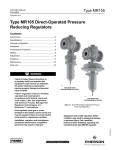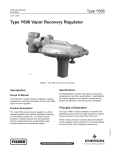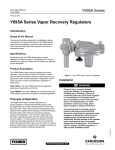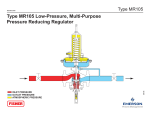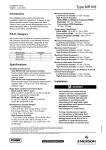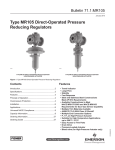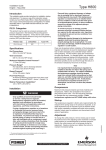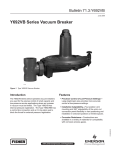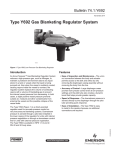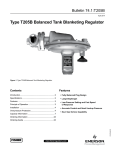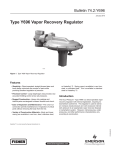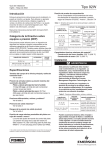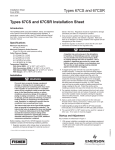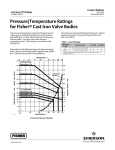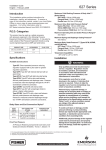Download Emerson MR105 Installation Guide
Transcript
Installation Guide English – June 2014 Type MR105 Introduction This installation guide provides instructions for installation, startup and adjustment. To receive a copy of the instruction manual, contact your local Sales Office or view a copy at www.fisherregulators.com. For further information refer to Type MR105 Instruction Manual, Form 5874, D103246X012. P.E.D. Category This product may be used as a pressure accessory with pressure equipment in the following Pressure Equipment Directive 97/23/EC categories. It may also be used outside of the Pressure Equipment Directive using sound engineering practice (SEP) per table below. PRODUCT SIZE CATEGORIES NPS 1 / DN 25 SEP NPS 2 / DN 50 II NPS 3 / DN 80 II NPS 4 / DN 100 II Specifications Available Constructions Type MR105 with low-pressure actuator: Directoperated large multi-purpose regulator with 5 to 43 psig / 0.35 to 3.0 bar pressure range. Type MR105 with high-pressure actuator: Directoperated large multi-purpose regulator with 25 to 300 psig / 1.7 to 20.7 bar pressure range. Body Sizes and End Connection Styles DN 25 and 50 / NPS 1 and 2: NPT, CL125 FF, CL250 RF, CL150 RF, CL300 RF, CL600 RF and EN PN 16/25/40 RF DN 80 and 100 / NPS 3 and 4: CL125 FF, CL250 RF, CL150 RF, CL300 RF, CL600 RF and EN PN 16 RF Maximum Inlet Pressures(1) Low-Pressure Actuator: 400 psig / 27.6 bar High-Pressure Actuator: 400 psig / 27.6 bar Maximum Outlet Pressures(1) Low-Pressure Actuator: 70 psig / 4.8 bar High-Pressure Actuator: 400 psig(2) / 27.6 bar Maximum Emergency Casing Pressures(1) Low-Pressure Actuator: 70 psig / 4.8 bar High-Pressure Actuator: 400 psig(2) / 27.6 bar Maximum Setpoint(1) Low-Pressure Actuator: 43 psig / 3.0 bar High-Pressure Actuator: Nitrile (NBR) and Ethylene Propylene (EPDM) Diaphragm: 300 psig / 20.7 bar Fluorocarbon (FKM) Diaphragm: 150 psig / 10.3 bar Outlet Pressure Ranges(1) NPS 1 and 2 / DN 25 and 50: Low-Pressure Actuator: 5 to 12 psig / 0.35 to 0.83 bar; 10 to 24 psig / 0.69 to 1.6 bar; 14 to 32 psig / 0.96 to 2.2 bar; 18 to 43 psig / 1.2 to 3.0 bar High-Pressure Actuator: 25 to 60 psig(3) / 1.7 to 4.1 bar; 43 to 100 psig / 3.0 to 6.9 bar; 75 to 175 psig(4) / 5.2 to 12.1 bar; 110 to 300 psig(4) / 7.6 to 20.7 bar NPS 3 and 4 / DN 80 and 100: Low-Pressure Actuator: 5 to 8 psig / 0.35 to 0.55 bar; 8 to 20 psig / 0.55 to 1.4 bar; 12 to 30 psig / 0.83 to 2.1 bar; 18 to 39 psig / 1.2 to 2.7 bar High-Pressure Actuator: 39 to 72 psig / 2.7 to 5.0 bar; 71 to 175 psig(4) / 4.9 to 12.1 bar; 110 to 250 psig(4) / 7.6 to 17.2 bar Temperature Capabilities(1) Nitrile (NBR): -20 to 180°F / -29 to 82°C Fluorocarbon (FKM): 20 to 250°F(5) / -7 to 121°C Ethylene Propylene (EPDM): -20 to 225°F / -29 to 107°C(6) Maximum Differential Pressures(1) Liquid Application: Low-Pressure Actuator: NPS 1 and 2 / DN 25 and 50: 200 psig / 13.8 bar NPS 3 and 4 / DN 80 and 100: 225 psig / 15.5 bar High-Pressure Actuator: NPS 1 / DN 25: 250 psig / 17.2 bar NPS 2 / DN 50: 200 psig / 13.8 bar NPS 3 / DN 80: 225 psig / 15.5 bar NPS 4 DN 100: 250 psig / 17.2 bar Other Applications: Low-Pressure Actuator: 400 psig / 27.6 bar High-Pressure Actuator: 400 psig / 27.6 bar Maximum Pressures over Set Pressure to Avoid Internal Parts Damage(1) Low-Pressure Actuator: 20 psig / 1.4 bar 1. The pressure/temperature limits in this Installation Guide or any applicable limitation should not be exceeded. 2. Maximum Outlet and Emergency Casing Pressures for constructions with Fluorocarbon (FKM) diaphragm are limited to 230 psig / 15.8 bar or the body rating limit, whichever is lower. 3. NPS 2 / DN 50 body size spring range is limited up to 45 psig / 3.1 bar only. 4. Maximum setpoint is limited to 150 psig / 10.3 bar for constructions with Fluorocarbon (FKM) diaphragm. 5. Fluorocarbon (FKM) is limited to 200°F / 93°C hot water. 6. Ethylene Propylene (EPDM) is limited to 20 to 250°F / -7 to 121°C when used with Low Pressure Actuator. www.fisherregulators.com D103246XUS2 High-Pressure Actuator: 120 psig / 8.3 bar Type MR105 Installation Note ! Warning Only qualified personnel should install or service a regulator. Regulators should be installed, operated and maintained in accordance with international and applicable codes and regulations and Emerson Process Management Regulator Technologies, Inc. instructions. If the regulator vents fluid or a leak develops in the system, it indicates that service is required. Failure to take the regulator out of service immediately may create a hazardous condition. Personal injury, equipment damage or leakage due to escaping fluid or bursting of pressure-containing parts may result if this regulator is overpressured or is installed where service conditions could exceed the limits given in the Specifications section or where conditions exceed any ratings of the adjacent piping or piping connections. To avoid such injury or damage, provide pressure-relieving or pressure-limiting devices (as required by the appropriate code, regulation or standard) to prevent service conditions from exceeding limits. Additionally, physical damage to the regulator could result in personal injury and property damage due to escaping fluid. To avoid such injury and damage, install the regulator in a safe location. Clean out all pipelines before installation of the regulator and check to be sure the regulator has not been damaged or has collected foreign material during shipping. For NPT bodies, apply pipe compound to the external pipe threads. For flanged bodies, use suitable line gaskets and approved piping and bolting practices. Vertical installation with the actuator oriented up or down is recommended. The unit will operate in horizontal installation with actuator on the side, however, this could result in premature wear of parts. Make sure that flow will be in the same direction as that indicated by the body arrow. Orientation of the two vents should always be down. Vents may be rotated after regulator installation so that the vent screens are down. A control line must be installed to allow outlet pressure to register on the actuator’s diaphragm. It should be installed four to eight pipe diameters downstream of the regulator and in an area of pipe that is free of turbulence. 2 It is important that the regulator be installed so that the vent hole in the spring case is unobstructed at all times. For outdoor installations, the regulator should be located away from vehicular traffic and positioned so that water, ice and other foreign materials cannot enter the spring case through the vent. Avoid placing the regulator beneath eaves or downspouts and be sure it is above the probable snow level. Overpressure Protection The recommended pressure limitations are stamped on the regulator nameplate. Some type of overpressure protection is needed if the actual inlet pressure exceeds the maximum operating outlet pressure rating. Overpressure protection should also be provided if the regulator inlet pressure is greater than the safe working pressure of the downstream equipment. Regulator operation below the maximum pressure limitations does not preclude the possibility of damage from external sources or debris in the line. The regulator should be inspected for damage after any overpressure condition. Startup The regulator is set at the factory for the setpoint specified on the order or at the midpoint of the spring range. The allowable spring range is stamped on the nameplate. If a pressure setting other than specified is desired, be sure to change the pressure setting by following the Adjustment section. With proper installation completed and relief valves properly adjusted, slowly open the upstream and downstream shutoff valves (if applicable). Adjustment To change the outlet pressure, loosen the locknut and turn the adjusting screw clockwise to increase pressure or counterclockwise to decrease pressure. Monitor the outlet pressure with a test gauge during the adjustment. Tighten the locknut to maintain the desired setting. Taking Out of Service (Shutdown) ! Warning To avoid personal injury resulting from sudden release of pressure, isolate the regulator from all pressure before attempting disassembly. Type MR105 Parts List Key 1 2 3 4 5 6 7 8 9 10 11 12 13 14 15 16 17 18 19 20 21 22 23 24 25 26 27 28 29 30 33 34 35 36 37 38 40 43 44 45 46 47 48 49 51 52 53 54 55 56 57 58 60 61 62 63 64 64 65 66 67 68 69 70 71 72 73 75 76 81 82 84 85 87 Description Valve Body Body Flange Stud Bolt Gasket Lower Indicator Fitting O-ring Retainer Indicator O-ring Hex Nut Valve Spring Indicator Stem Cage Port Seal Seat Ring Piston Ring Upper Seal Valve Plug Cage O-ring Travel Indicator Scale Travel Indicator Protector Valve Plug O-ring Lower Indicator Fitting O-ring Flange Nut E-Ring Drive Screw Flow Arrow Vent Plug Spring Seat Hex Nut Pipe Plug NACE Tag (not shown) Seal Wire (not shown) Indicator Fitting Back O-ring Indicator Fitting O-ring Pipe Plug Actuator Stem Nameplate Lube Fitting Wiper Ring Bearing Valve Stem O-ring Jam Nut 67 Spring Washer A A Lower Diaphragm Head O-ring Lower Spring Guide Lower Diaphragm Head 57 Lower Spring Seat Diaphragm Plate Diaphragm 73 Cap Screw or Stud Bolt Hex Nut 72 Bonnet O-ring Bonnet 70 Lower Diaphragm Casing Upper Diaphragm Casing 43 Spring Case Spacer O-ring Upper Diaphragm Casing O-ring 44 Cap Screw Spring Case Spacer 30 Cap Screw Control Spring Upper Spring Seat 26 Spring Case Seal Washer (not shown) 38 Jam Nut Adjusting Screw 1 Restrictor (not shown) Pipe Bushing 2 Pipe Nipple (not shown) Drain Valve (not shown) 25 Plate 24 Internal Stiffener Bleed Valve (not shown) Upper Casing Welding Assembly (not shown) 69 52 25 68 66 76 65 26 55 63 V 53 56 X 58 65 62 84 Z 13 51 Y 61 12 40 11 17 4 16 9 3 29 67 A 67 57 64 67 43 43 57 73 73 7228 28 72 6 70 70 6 43 4321 21 37 44 4435 30 37 30 8 26 35 2618 38 81 38 182 1 24 2 28 6 21 37 35 8 18 GE38435 67 A 67 4 57 57 69 24 57 73 24 52 73 2464 72 43 7228 2 70 66 23 70 6 6 43 6523 23 10 10 4321 2 44 63 10 5 37 30 56 55 4435 3 26 58 30 8 3 38 62 W 2618 8 1 51 22 22 38 2 61 1 19 19 1 24 24 25 4022 25 2 1719 16 Figure 1. Type MR105 Assembly Drawings 3 3 Type MR105 7 36 46 60 DETAIL W 54 64 47 15 20 14 63 DETAIL X DETAIL Y 58 47 46 57 45 GE38435 62 49 27 DETAIL Z 56 48 21 NO TRAVEL INDICATOR 53 DETAIL V Figure 1. Type MR105 Assembly Drawings (continued) Industrial Regulators Natural Gas Technologies TESCOM Emerson Process Management Regulator Technologies, Inc. Emerson Process Management Regulator Technologies, Inc. Emerson Process Management Tescom Corporation USA - Headquarters McKinney, Texas 75070 USA Tel: +1 800 558 5853 Outside U.S. +1 972 548 3574 USA - Headquarters McKinney, Texas 75070 USA Tel: +1 800 558 5853 Outside U.S. +1 972 548 3574 USA - Headquarters Elk River, Minnesota 55330-2445, USA Tels: +1 763 241 3238 +1 800 447 1250 Asia-Pacific Shanghai 201206, China Tel: +86 21 2892 9000 Asia-Pacific Singapore 128461, Singapore Tel: +65 6770 8337 Europe Selmsdorf 23923, Germany Tel: +49 38823 31 287 Europe Bologna 40013, Italy Tel: +39 051 419 0611 Europe Bologna 40013, Italy Tel: +39 051 419 0611 Chartres 28008, France Tel: +33 2 37 33 47 00 Asia-Pacific Shanghai 201206, China Tel: +86 21 2892 9499 Middle East and Africa Dubai, United Arab Emirates Tel: +011 971 4811 8100 Middle East and Africa Dubai, United Arab Emirates Tel: +011 971 4811 8100 For further information visit www.fisherregulators.com The Emerson logo is a trademark and service mark of Emerson Electric Co. All other marks are the property of their prospective owners. Fisher is a mark owned by Fisher Controls International LLC, a business of Emerson Process Management. The contents of this publication are presented for informational purposes only, and while every effort has been made to ensure their accuracy, they are not to be construed as warranties or guarantees, express or implied, regarding the products or services described herein or their use or applicability. We reserve the right to modify or improve the designs or specifications of such products at any time without notice. Emerson Process Management Regulator Technologies, Inc. does not assume responsibility for the selection, use or maintenance of any product. Responsibility for proper selection, use and maintenance of any Emerson Process Management Regulator Technologies, Inc. product remains solely with the purchaser. ©Emerson Process Management Regulator Technologies, Inc., 2010, 2014; All Rights Reserved




